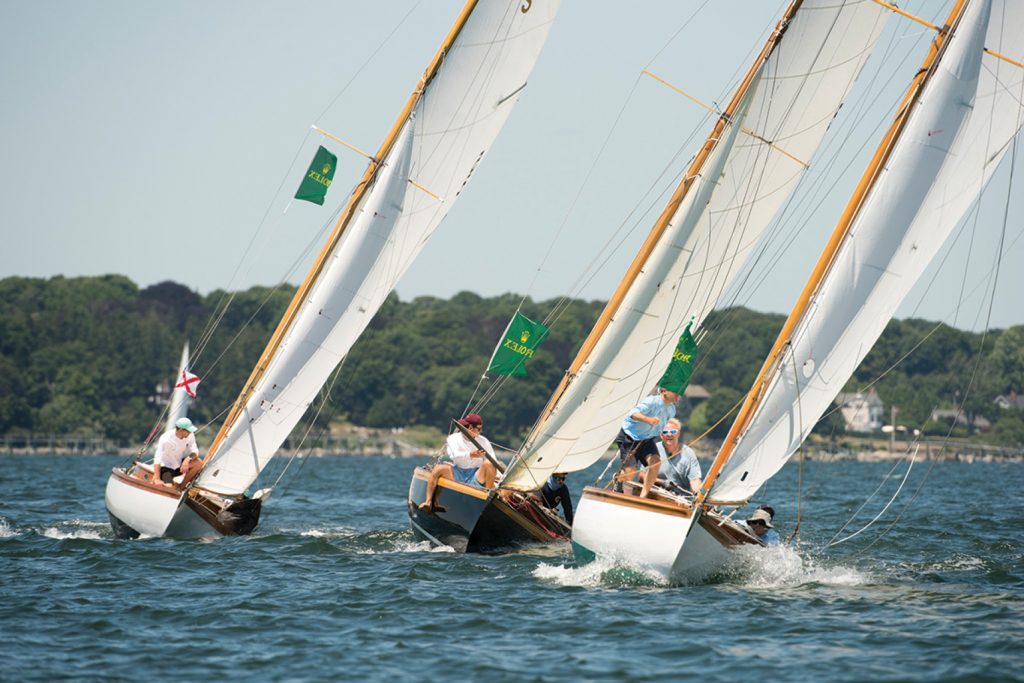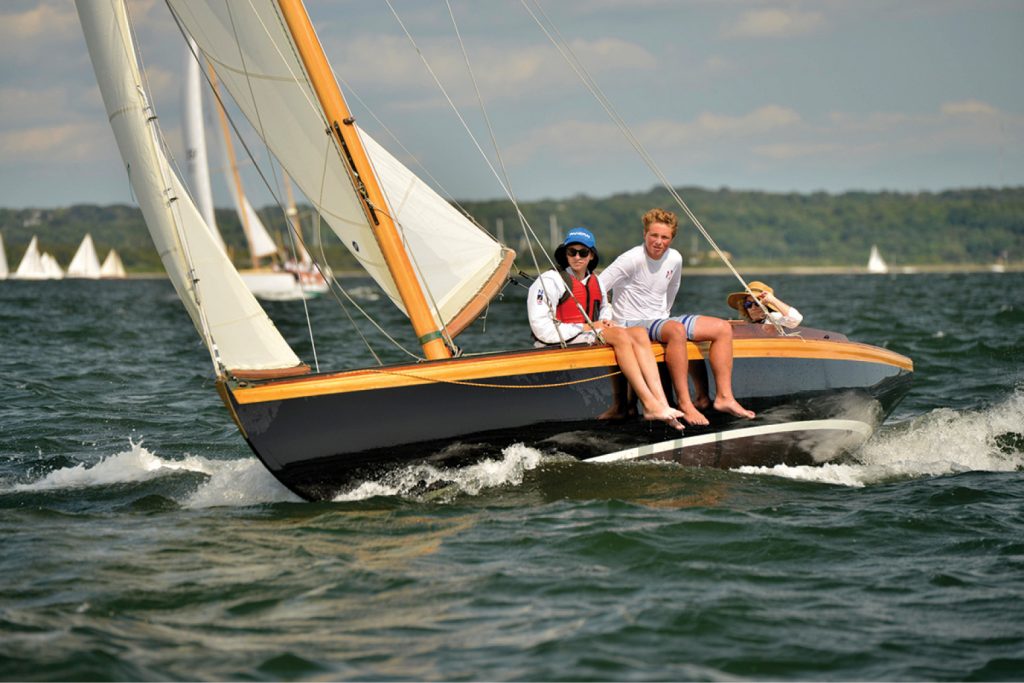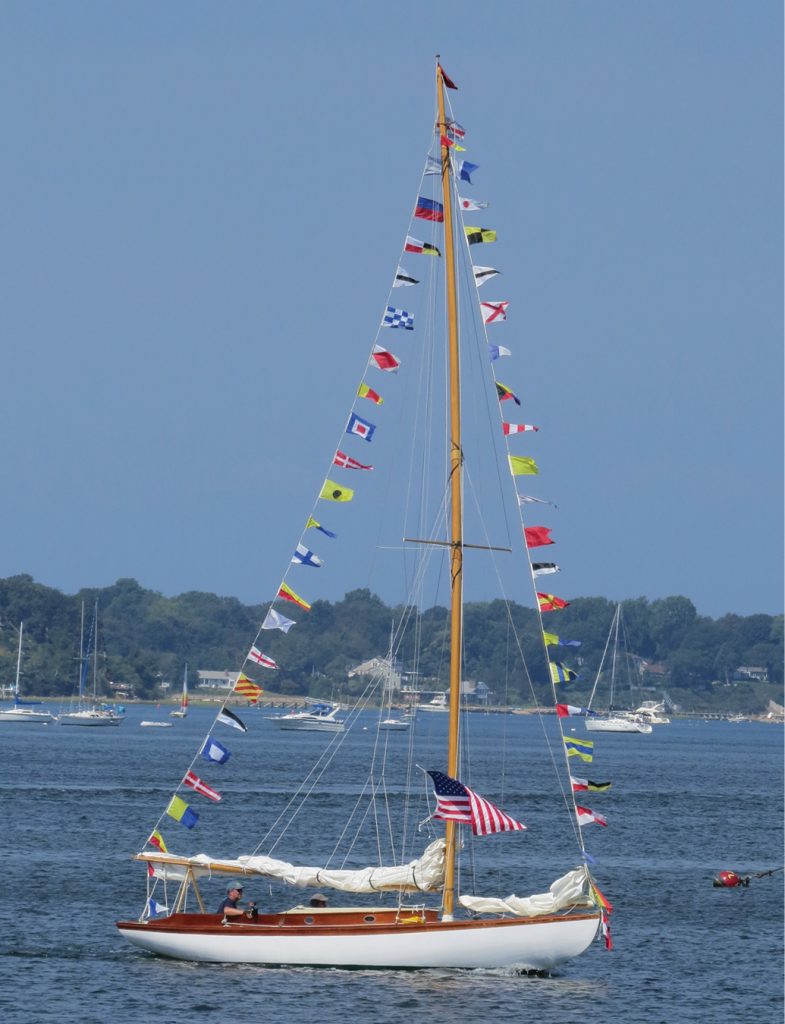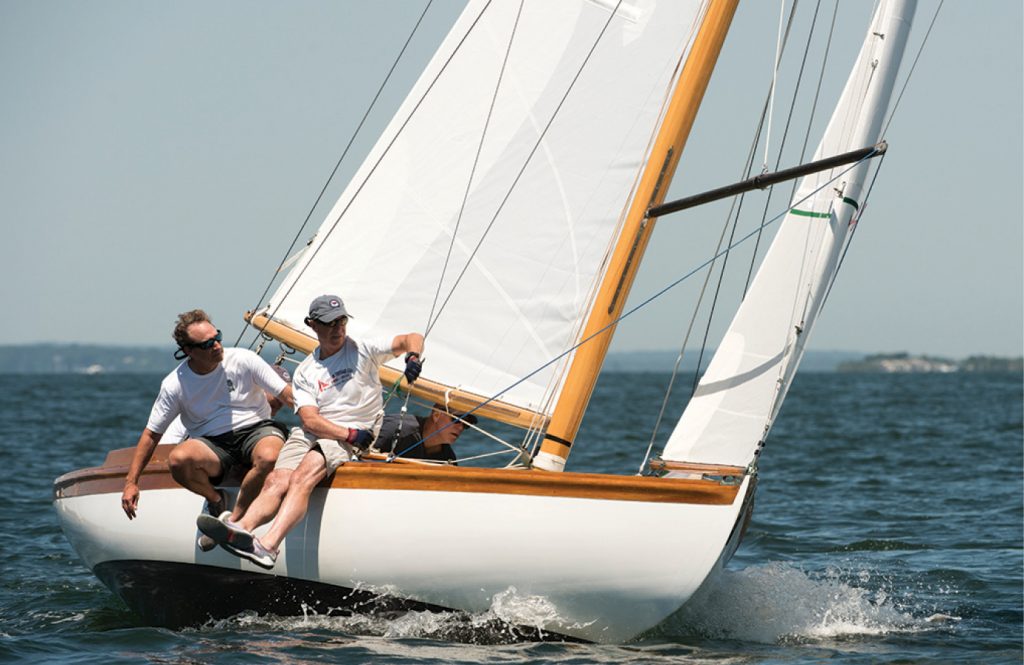
S Boats in action at New York Yacht Club Race Week presented by Rolex. © Allen Clark/PhotoBoat.com
By David Hubbard
One hundred years ago, the most famous boat designer of all time, Nathanael Greene Herreshoff, aka “Captain Nat,” aka “The Wizard of Bristol,” was 71 years old, and quite possibly at the height of his powers as a sailboat designer. If you own a sailboat, or have ever seen a modern sailboat, you should give him a nod for what he was about to do; that is to design the “S Boat,” of which about 94 were built by Herreshoff between 1919 and 1941, and a few under license by Lawley. Almost 70 still exist, and over 30 are actively raced in the Northeast. Of course, a 100-year-old design that popular deserves a celebration!
Nat was well into preparing the next America’s Cup yacht, Resolute, for the 1920 Cup regatta. A few years prior, he was instrumental in creating the “Universal Rule,” a formula for handicapping sailboats. Previously, the rules did not account for displacement, which was leading to light boats with huge sail areas, and things were getting dangerous. The Universal Rule accounted for displacement, as well as things like sail area, and waterline length. The formula puts out a number, and each range of numbers was assigned a letter. The largest range was given “J,” and the venerable America’s Cup yachts of the time were the 120-foot “J Boats.” The smallest was assigned “S,” but none were designed until 1919.

Geoffrey Davis’ Aquila, built in 1920 and sailing out of Bristol Yacht Club, shows off her gleaming brightwork at the IYRS Classic Yacht Regatta. © Allen Clark/PhotoBoat.com
The new rule heavily weighted waterline length (a longer boat would get a greater handicap), but only with the boat upright. Thus, the Universal Rule boats were all designed with beautiful overhangs in the bow and stern. This was not really for good looks, but because as the boat heeled over, it also got longer in the water. And since boat speed for a displacement hull is limited by waterline length (known as ‘hull speed’), this allowed the boats to use this ‘unrated’ length to go faster. Hull speed is caused by the hull making its own wave, and as the stern dips into the wake, the boat is now trying to go uphill and requires a lot more energy to do so. This is from the speed of a wave through water, which in knots is limited to 1.34 times the square root of the wavelength in feet from crest to crest.
The story goes that in 1919, a group from Seawanhaka Yacht Club in Oyster Bay, New York asked Nat for a high-performance daysailer, suitable for racing on Long Island Sound (although it seems that the first shipments went to other clubs). Thus, the “S Boat” was born. Now strictly speaking, Universal Rule boats are “Formula Boats,” meaning there is some flexibility in the design. You can trade off sail area for length, for example. But in fact, the S Boats were all identical, so they’re also a “One-Design.”
But the S Boat was not just another Herreshoff design! For starters, Nat was known for designing boats specifically for the area they would be sailed, accounting for wind, waves, depth, etc. And he was known to not let his customers design the boats. He got their general requirements and did his own thing! So, these were the first production line of boats to have what we now accept as a standard, the “Bermudan” or “Marconi” rig with the triangular mainsail we know today. Prior to that, most boats were gaff-rigged. Those had a four-sided main sail supported by an upper ‘gaff boom.’ In fact, it’s said that the America’s Cup folks were evaluating this new design for Resolute, and probably sailed an S Boat. They may have decided it was too risky a change and stayed with the gaff rig, but after 1920 all America’s Cups were sailed with the new rig.

Clara J, the author’s S Boat, was beautifully restored at IYRS in 2014.
S Boats have a 20.5’ waterline length (LWL), but the overhangs extend the overall length (LOA) to 27.5’, allowing them to stretch out to 24’ or so when heeled over. They have what is known as a ‘hollow bow,’ a new design at the time to help handle waves. They weigh in at 6,750 pounds, with a big 3,350-pound piece of lead as the entire bottom of the keel. The keel is also fairly short, allowing the boats to turn on a dime – faster than many modern boats!
Another feature is the signature curved mast. The top of the 42’ mast curves backwards. The theory I’ve heard is that in heavy conditions, as the boat heels, the top of the main dumps air, and brings the ‘center of effort’ down and forward, and that combined with the low weight and 50% ballast, stiffens and balances the boat as it gets its rail in. And with the rail in, they fly! Most racers don’t even reef, and when properly trimmed, owners say they can be sailed with just two fingers on the tiller, even in a good breeze!

Looking good on her 100th birthday is Andrew McClatchy’s Swallow, winner of the S Boat class at New York Yacht Club Race Week presented by Rolex in 2018. © Allen Clark/PhotoBoat.com
Another unique feature is that the spreaders are on a ring which can rotate when the main presses against them downwind. This removes torque on the hollow Sitka Spruce mast, allowing more horsepower safely. They also are easy to sail. They have a very small, self-tacking jib, which has its own boom that swings inside the bow. Unlike modern boats which get a lot of their power from the jib, the S Boat jib is more for trim. It just needs one sheet, has its own traveler on the foredeck, and when tacking upwind you don’t need to touch it! You can just drive!
S Boats also have an adjustable forestay, which allows for flexibility in shaping the 340-square foot mainsail, which gives the boats a 19:1 sail area to displacement ratio. This is very high even by today’s standards, and S Boats can overtake modern boats downwind. This huge main results in the boom overhanging the stern, and thus no backstay. They have “running backstays,” which are stays on tracks on each side, and lines that run through “cheek blocks” on the deck to pull them fore and aft: back on the upwind side to support the mast, and forward to get them out of the way of the boom when off the wind, although they can both be left back when close-hauled. This is the only tricky part of jibing – you must switch these or risk breaking your mast! With these features, the S can also out-point most modern boats, except those designed specifically for racing.
They are also beautiful boats, with Eastern White Cedar over tapered oak frames. Owners could choose from Oak, Teak, or Mahogany for the trim, including the signature Herreshoff ‘Molded Sheerstrake’ (the topmost plank meeting the deck), which is left varnished, never painted, and is striking.
They have a small cuddy cabin, and the design showed an option for a bigger cabin for light cruising, although it seems only one of these was built.
Three fleets of “S” Boats race actively as a one-design: one in western Long Island Sound, one in Narragansett Bay around Newport, and one in Quissett, Massachusetts. Several other boats race in mixed fleets on a handicap basis (PHRF around 210 depending on area).
This summer, we’re celebrating the centennial of the design with regattas in Larchmont, New York, Newport, Rhode Island, and the Herreshoff Marine Museum in Bristol, Rhode Island. We have located over 67 of the original 100+ boats and there will likely be close to 30 boats on the line, making these some of the largest races of classic one-design boats ever, not to mention a 100-year-old design!
There are always a few S Boats for sale. Some in excellent shape, such as those restored by the IYRS School of Technology & Trades in Newport (where mine, Clara J, Hull # 1385, was restored) and other classic wooden boat shops such as Bristol Boat, Baltic Boatworks, East Passage Boatwrights, and Wooden Boatworks. And there are always a few in need of a new caretaker! We don’t really own our boats…most of us see ourselves as caretakers of a piece of history.
So, come on out to watch (or even crew) some of the classic races we have planned! For more information, see sclass.org, herreshoffregistry.org/doc/Class_Description_S_Class.pdf, and instagram.com/herreshoff_s_class/ ■
David Hubbard started sailing out of Black Rock Yacht Club in Bridgeport, Connecticut. “I’m told I was in a hammock on board the family Herreshoff Fishers Island 23 when just a few months old,” he says. He’s the Fleet Captain for the Port Jefferson Yacht Club racing program, a US Sailing-certified race officer, and an IYRS ambassador. Now retired, he combined his career in software development with his love of sailing and wrote RaceTac, an Android app tailored specifically for racers, and RaceTac Committee, an app for Android and Apple to support race committees.



